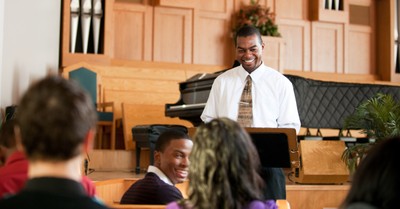Joseph and Mary: Raw and Unfiltered (2023)
- Published Dec 12, 2023
There are at least two overlooked aspects of the story of Joseph and Mary. Yet knowing about these two dynamics to their life adds even more wonder to the Christmas story.
The first has to do with age. Mary would have been young, but Joseph was not. They had what we might call a “May-December romance.” And by our standards, very May and very December. He was probably in his 30s or 40s, and she may have been as young as 13. We can assume that because engagement for a woman usually took place immediately after entering puberty, which means Mary may have just entered her teens—13, 14 or at the oldest 15. Men would marry later, when they could be a financial provider and have their trade in hand. The earliest would be late teens or early 20s.
But signs point to Joseph being older than that. Since we don’t hear anything about Joseph once Jesus is an adult, it’s likely that sometime between the time when Jesus was 12 and 30 years old, Joseph died.
The last record of Joseph is from when Jesus was 12, when Mary and Joseph took Jesus to the Temple. The next scene from the life of Jesus – in all four biographical accounts of His life in the Bible – was when Jesus was 30 and began His public ministry. In all four accounts of Jesus’ life, not a word is mentioned of Joseph during that time. When Jesus returns home, when Jesus interacts with Mary, when Jesus is interacting with members of His family… no Joseph. And on the cross, before His death, Jesus asks John to watch over Mary. This intimates that Jesus, as the eldest son, had carried that responsibility to that point, and was now asking another to help watch over His mother.
Which tells us that Mary was a widow and that sometime between the ages of 12 and 30 (probably in Jesus’ teen years) Joseph died.
Not many people realize that Jesus was raised, at least for a season, by a single-parent mom.
There’s an old tradition (not in the Bible, just an old tradition) that says that Joseph lived until he was 111 years old, dying when Jesus was 18. That he had been married with children before Mary, but his first wife had died. That would make him a very elderly man when he was betrothed to Mary—around 92 years of age.
But regardless of exactly when he died, or what filled his life before this marriage, his death explains why Jesus didn’t begin His public ministry until the age of 30. He was providing for the family, carrying on with His father’s trade that He had been taught by His father, which most hold to being carpentry.
And yes, carpentry would have been a part of his trade, but the Greek word that describes what Joseph’s trade was and that is often translated as “carpenter” really was more generic—it was “builder.” He was a builder, and he would have used whatever necessary building resources he had. And if you know anything about where this story took place, trees are few and far between. They would use lumber, but more often they would use what was readily available, which was stone. So if you really want to get into your head an idea of what Joseph’s craft was and what Jesus did, they were stone masons.
Which brings us to another aspect of their life: poverty. This could be assumed from Joseph’s line of work, but we know it for a fact because of what took place on the 40th day after the birth of Jesus, when Mary and Joseph took Jesus to Jerusalem.
Following the birth of a son, a mother had to wait 40 days before going to the Temple to offer a sacrifice for the purpose of her purification. If she had a girl, that length of time was doubled. The purpose was to consecrate the baby to God. Back then, it was usually just the firstborn who was dedicated in this way because it was the firstborn who had all the rights of inheritance.
As part of that dedication, it was common to give a sacrifice or an offering to God. We are told that they offered a pair of doves or a pair of pigeons according to the law of Moses.
This is how we know they were poor.
The best and most common sacrifice was a lamb, and you were only allowed to bring something else if you didn’t have the money for a lamb. To give a lesser offering, you had to get special approval from Temple officials – a recognition that you were so poor that you couldn’t afford anything else – for a pair of doves or a pigeon to be accepted. So the poverty had to be extreme, and the poverty had to be proven. Theirs obviously was.
Why does this matter to the story of Christmas?
Because out of all the human beings on planet Earth, in all the situations those humans lived, Mary and Joseph were the two selected to be the parents for the coming of God in human form.
Fragile, poor, the death of the father imminent.
As Philip Yancey has written, the very birth of Jesus is about God wanting to be approachable. The God who could have roared, “who could order armies and empires about like pawns on a chessboard, this God emerged... as a baby who could not speak or eat solid food or control his bladder, [and] who depended on a [poor] teenage mother for shelter, food and love.”
This, among so many other things, gives depth to the meaning of the word used so often during the Christmas season: Emmanuel.
“God with us.”
James Emery White
Editor’s Note
This blog first released in 2022. The Church & Culture Team thought you would enjoy reading it again this year. Merry Christmas!
Sources
Philip Yancey, The Jesus I Never Knew.
About the Author
James Emery White is the founding and senior pastor of Mecklenburg Community Church in Charlotte, NC, and a former professor of theology and culture at Gordon-Conwell Theological Seminary, where he also served as their fourth president. His latest book, Hybrid Church: Rethinking the Church for a Post-Christian Digital Age, is now available on Amazon or from your favorite bookseller. To enjoy a free subscription to the Church & Culture blog, visit churchandculture.org where you can view past blogs in our archive, read the latest church and culture news from around the world, and listen to the Church & Culture Podcast. Follow Dr. White on X, Facebook and Instagram at @JamesEmeryWhite.
The views expressed in this commentary do not necessarily reflect those of CrosswalkHeadlines.
James Emery White is the founding and senior pastor of Mecklenburg Community Church in Charlotte, NC, and a former professor of theology and culture at Gordon-Conwell Theological Seminary, where he also served as their fourth president. His latest book, Hybrid Church: Rethinking the Church for a Post-Christian Digital Age, is now available on Amazon or from your favorite bookseller. To enjoy a free subscription to the Church & Culture blog, visit churchandculture.org where you can view past blogs in our archive, read the latest church and culture news from around the world, and listen to the Church & Culture Podcast. Follow Dr. White on X, Facebook and Instagram at @JamesEmeryWhite.



















